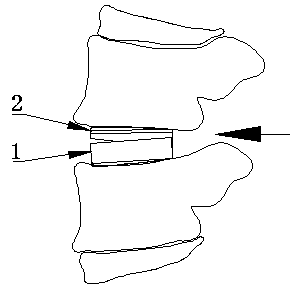Posterior lumbar interbody fusion device and using method
A fusion device and intervertebral technology, applied in the direction of spinal implants, etc., can solve problems such as stress shielding, non-fusion, and low fusion rate, so as to avoid delayed inflammatory response, good biocompatibility, The effect of increasing the fusion area
- Summary
- Abstract
- Description
- Claims
- Application Information
AI Technical Summary
Problems solved by technology
Method used
Image
Examples
Embodiment 1
[0042] Embodiment 1 A kind of posterior lumbar intervertebral fusion device
[0043] Such as figure 1 , figure 2 with image 3As shown together, the present invention provides a posterior lumbar intervertebral fusion device, which includes a lower body 1 of the fusion device and an upper body 2 of the fusion device. A matrix material capable of cell induction and culture; the two cooperate to form a wedge-shaped structure, and the wedge-shaped structure forms a seesaw effect with the middle ball socket as the fulcrum with the change of the intervertebral lordosis angle to adapt to the shape of the intervertebral space. The size of the lower body 1 of the fusion device and the upper body 2 of the fusion device can be set to a general specification model, or can be obtained according to patient imaging data.
[0044] Such as figure 2 , image 3 , Figure 4 with Figure 5 As shown together, the lower body 1 of the fusion device includes a rectangular main body 101, the r...
Embodiment 2
[0047] Embodiment 2 A method of using the posterior lumbar intervertebral fusion device
[0048] Such as Figure 1 to Figure 8 Commonly shown, the present invention provides a method for using the posterior lumbar intervertebral fusion device, which specifically includes the following steps:
[0049] Step 1: Use absorbable medical polymer materials to 3D print out the brackets for the lower body 1 of the fusion cage and the upper body 2 of the fusion cage according to the preset specifications and models;
[0050] Step 2: loading matrix materials that induce cartilage tissue growth into the scaffolds of the lower body 1 of the fusion device and the upper body 2 of the fusion device;
[0051] Step 3: Making the scaffold produce micropores suitable for chondrocyte growth in a suitable way;
[0052] Step 4: Take the patient's bone marrow stromal stem cells and load them into the scaffold for stem cell induction culture to obtain a tissue engineered lumbar intervertebral fusion ...
PUM
 Login to View More
Login to View More Abstract
Description
Claims
Application Information
 Login to View More
Login to View More - Generate Ideas
- Intellectual Property
- Life Sciences
- Materials
- Tech Scout
- Unparalleled Data Quality
- Higher Quality Content
- 60% Fewer Hallucinations
Browse by: Latest US Patents, China's latest patents, Technical Efficacy Thesaurus, Application Domain, Technology Topic, Popular Technical Reports.
© 2025 PatSnap. All rights reserved.Legal|Privacy policy|Modern Slavery Act Transparency Statement|Sitemap|About US| Contact US: help@patsnap.com



